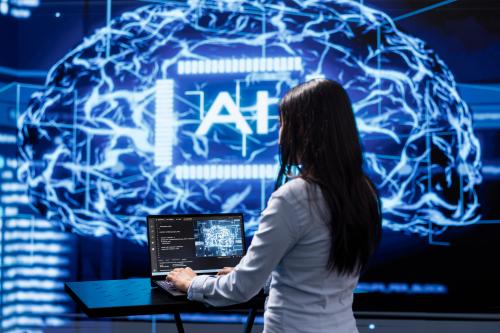Artificial intelligence has emerged as a general purpose technology with far-reaching consequences for industries, places, and people.
AI systems promise to drive productivity by automating routine tasks or augmenting work, allowing humans to focus on higher-value activities. The technology is also accelerating the pace of discovery and innovation by analyzing vast datasets and identifying patterns humans might miss. And for that matter, AI enables more efficient resource allocation through intelligent forecasting and optimization.
As such, AI could heavily influence the nation’s ability to achieve its larger goals, whether it be through faster drug development, personalized learning, or “virtual employees” optimizing supply chain complexities.
With that in mind, it matters a lot whether and which U.S. cities and regions are prepared to facilitate AI development in high-quality ways, and are therefore demonstrating a readiness to truly benefit from future AI build-out.
What does it mean to be ‘ready’ for AI?
The nation’s general readiness to benefit from AI is critical, because the technology is going to play a significant role in economic development given its potential to drive efficiency, innovation, and productivity in every industry, both nationally and within regions.
Overall, readiness for AI—as an emergent, innovation-driven technology—will depend on the nation’s ability to deliver on these critical pillars:
- The availability of abundant AI talent, since talent clusters are critical in generating self-reinforcing economic growth for people, firms, and places.
- The accessibility of AI innovation and innovation infrastructure, since technical progress plays a disproportionate role in economic growth and builds on itself.
- Actual adoption of AI by organizations, because broad technology adoption remains an important driver of productivity growth and living standards.
AI readiness also matters for regions
At the same time, AI adoption at the regional level matters equally for economic development, prosperity, and the flourishing of communities. Individual places must pay attention to the local presence of the three pillars of AI readiness to ensure their success.
After all, AI very much reflects the tendency of emerging digital industries to cluster in a short list of large, tech-focused “early-adopter” hubs, as Brookings has described in previous reports.
At the same time, digital industries, including AI, tend to gradually diffuse across the country at varied speeds with varied adoption patterns.
In response, this analysis expands on an earlier study to examine the extent, location, and concentration of AI assets, capabilities, and activity in U.S. metropolitan areas.
Employing 14 basic measures, the report benchmarks regions based on their core AI assets and capabilities as they relate to three pillars of AI readiness: talent, innovation, and adoption. In doing so, the assessment categorizes 195 metro areas into six tiers of regional AI involvement and recommends starting points and strategies based on the level and type of involvement.
Read more about our data and methodology on page 6 of the full report. >>
Turning to the results of the assessment, analysis of the 14 measures of AI economic activity across the U.S. yields several broad findings about the industry, its characteristics, and its geography.
The nation’s AI enterprise is growing rapidly, though it remains modest in size
One of the clearest indicators of AI’s expanding footprint in the U.S. economy is the rising share of businesses reporting current or anticipated use of AI technologies.
The main AI enterprise is concentrated in a limited number of metro areas, but numerous other regions are home to meaningful AI activity
Along these lines, the present analysis depicts an AI sector that remains concentrated in the nation’s most familiar coastal tech centers, but is beginning to spread across the country with varying degrees and types of local clustering.
Continuing the pattern Brookings reported in 2021, the major AI community types revealed by the present cluster analysis include:
Superstars: The San Francisco and San Jose metropolitan areas exhibit unmatched strength across all three AI success pillars (talent, innovation, and adoption).
Star Hubs: This group of 28 metro areas forms a second echelon of uniformly strong AI ecosystems, balancing top‑tier talent, research, and enterprise uptake.
Emerging Centers: This group of 14 metro areas combines top performance in two pillars with one developing area.
Focused Movers: This group of 29 metro areas excels in one AI pillar while maintaining foundations in the other two.
Nascent Adopters: This group of 79 metro areas shows moderate performance across all three pillars.
Others: This group of 43 metro areas currently lags on multiple pillars.
In addition, the analysis also touches on 192 of the nation’s smaller metro areas.
As the above map shows, the six cluster types account for varied, disparate chunks of the AI economy, with wide scattering across Eastern, Midwest, and Sun Belt states.
The six cluster types are characterized by varied strengths across the three pillars. In this regard, the two Superstar metro areas reflect broad and dominant strength across all success pillars. Likewise, the Star Hubs group displays its own strong but less dominant balance across the three pillars. The rest of the cluster groups display varied configurations that all tend to reflect modest talent availability, thinner innovation resources, and somewhat stronger adoption activity.
Current and emerging regional AI performance is informed by varied local mixes of success factors
Zooming in on the distribution of individual success factors across the clusters reveals the varied presence of the 14 metrics across the six community types.
Again, the Superstars stand out for their dominant shares of talent, innovation, and adoption metrics, although in some cases the Star Hubs rival those shares. By contrast, the Nascent Adopters’ ecosystems tend to lag on talent and innovation metrics but exhibit notable adoption activity.
Read more about the six cluster types starting on page 26 of the full report. >>
To view detailed data for a particular metropolitan area, select a metropolitan area in the interactive feature below.
To be sure, the great AI Superstars in the Bay Area continue to dominate, but the broader map depicts both welcome decentralization and too many areas that lack significant AI activity.
It is the case that the low-cost and simple use of generative AI applications in business will enable its eventual wider diffusion. But the fact remains that the trends and data analysis reported here depict only modest diffusion beyond the primary AI centers. This pattern of “frontier” hubs and broad “hinterlands” reflects the relatively slow dispersion of activity across space that economist Nicholas Bloom, ourselves, and others say frequently characterizes the market and spatial structure of digital economies.
All of which raises the question of whether anything should be done about these trends. Some will deny the need, insisting on the sovereignty of the private market. For such observers, the unevenness of AI diffusion is a market-ordained inevitability of the vaunted U.S. innovation system, and, in any event, not likely a problem.
Yet it is possible that deficits in regional AI development in too many places will foreclose on opportunities for aggregate progress, which suggests the advisability of actions that might help AI spread to more places.
Lagging regions, in this vein, entail opportunity gaps that reduce workers’ and communities’ ability to reap the rewards of AI because:
- Pools of U.S. talent are lost.
- Promising research and innovation resources go undeveloped.
- Adoption is slowed because too many inventors, startups, and industry use cases remain peripheral.
Given that, it behooves both the nation and its regions (including state and municipal governments, philanthropies, and local businesses) to work together to augment and widen the reach of AI development in more areas.
To that end, the nation needs to build out a strong AI-support platform at the same time as cities, states, firms, and community actors develop a region-by-region strategy that begins with regions’ individual starting points and uses them to shape local AI research agendas, foster regional cluster development, and build local talent in ways oriented to local needs. Both priorities need to be pursued to ensure U.S. AI development proves both dynamic and widespread.
Along these lines, each AI cluster’s local starting point suggests various priorities for near-term strategies:
- Superstars: Support emerging “Little Tech” companies, maintain appeal to immigrant talent, invest heavily in local tech education, and consider options for worker-transition support.
- Star Hubs and Emerging Centers: Invest in developing regional clusters, increase access to high-speed and affordable computing resources, and intensify efforts in tech education.
- Focused Movers: Lean into signature strengths and invest in the computing infrastructure necessary to train and retain top talent, prioritize tech transfer and commercialization, and leverage local business environments to promote adoption.
- Nascent Adopters and Others: Promote broad AI literacy, demonstrate practical AI applications in routine tasks, and think about AI career pathways.
In sum, the emergence of AI as a general purpose technology presents an inflection point for regional economic development in the United States. Leaders should move urgently to promote local development that will contribute to more evenly distributed AI growth from coast to coast.
See a detailed list of benchmarked metropolitan areas with rank positions and groups in the interactive table below:
The Brookings Institution is committed to quality, independence, and impact.
We are supported by a diverse array of funders. In line with our values and policies, each Brookings publication represents the sole views of its author(s).





